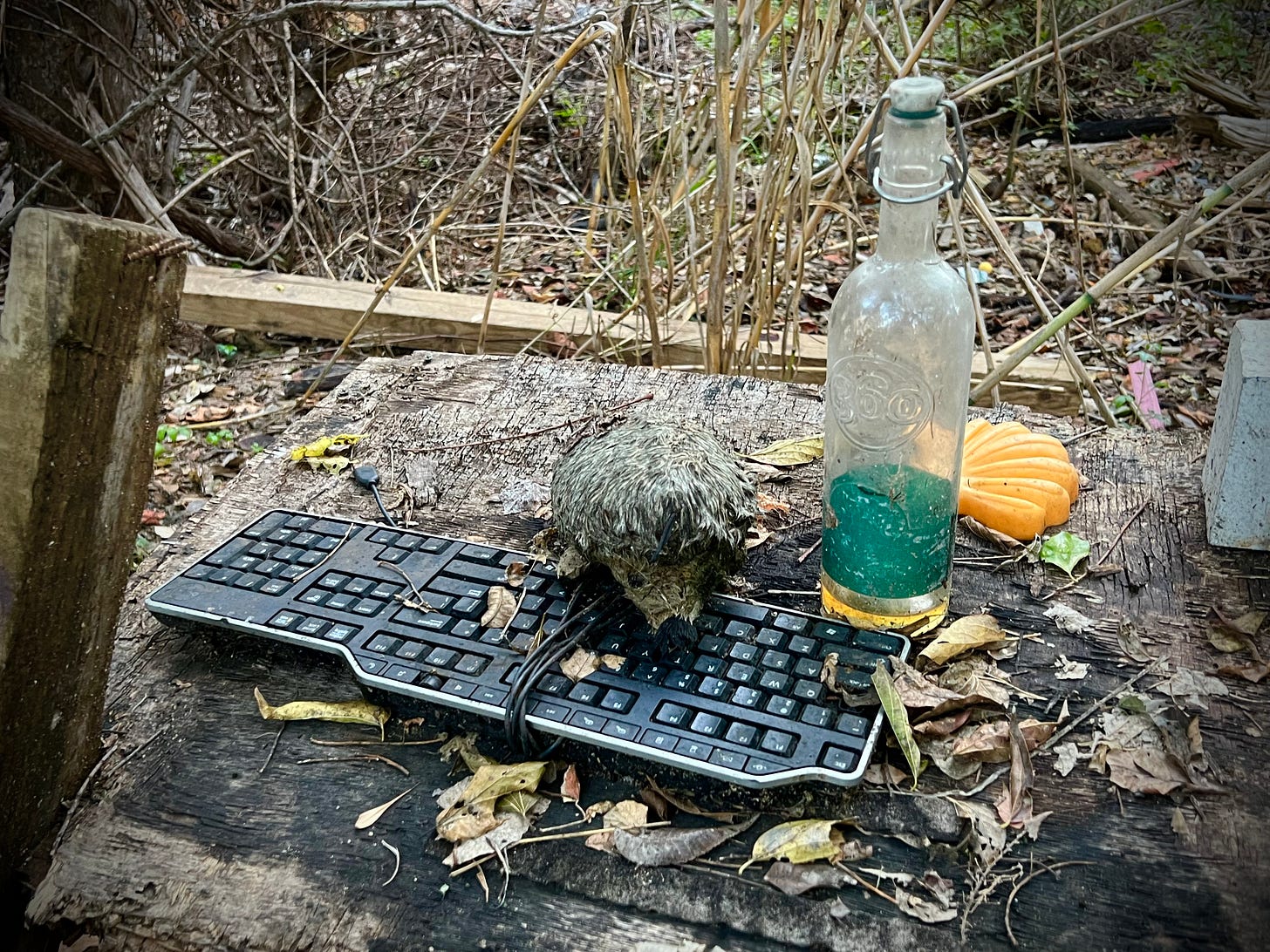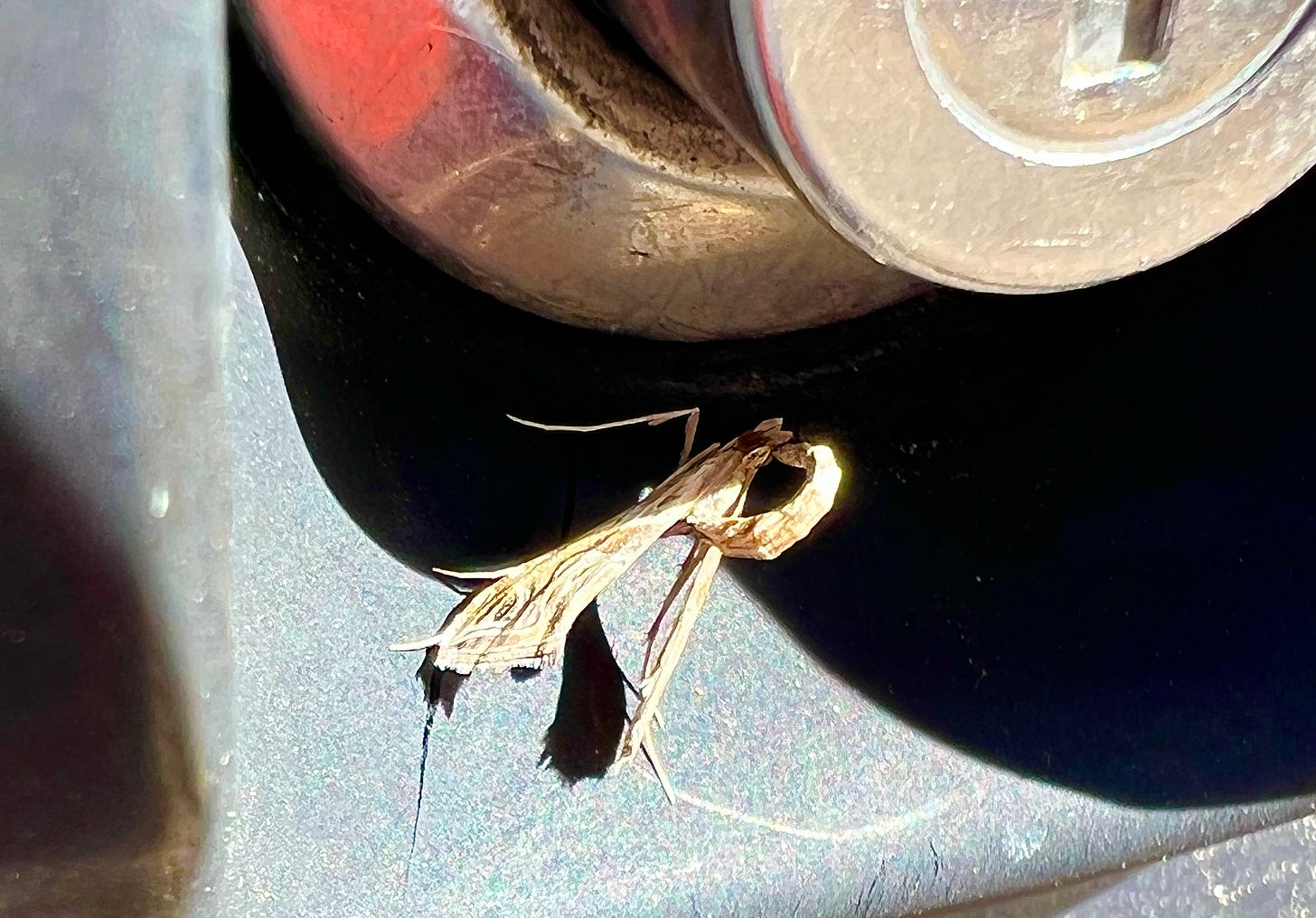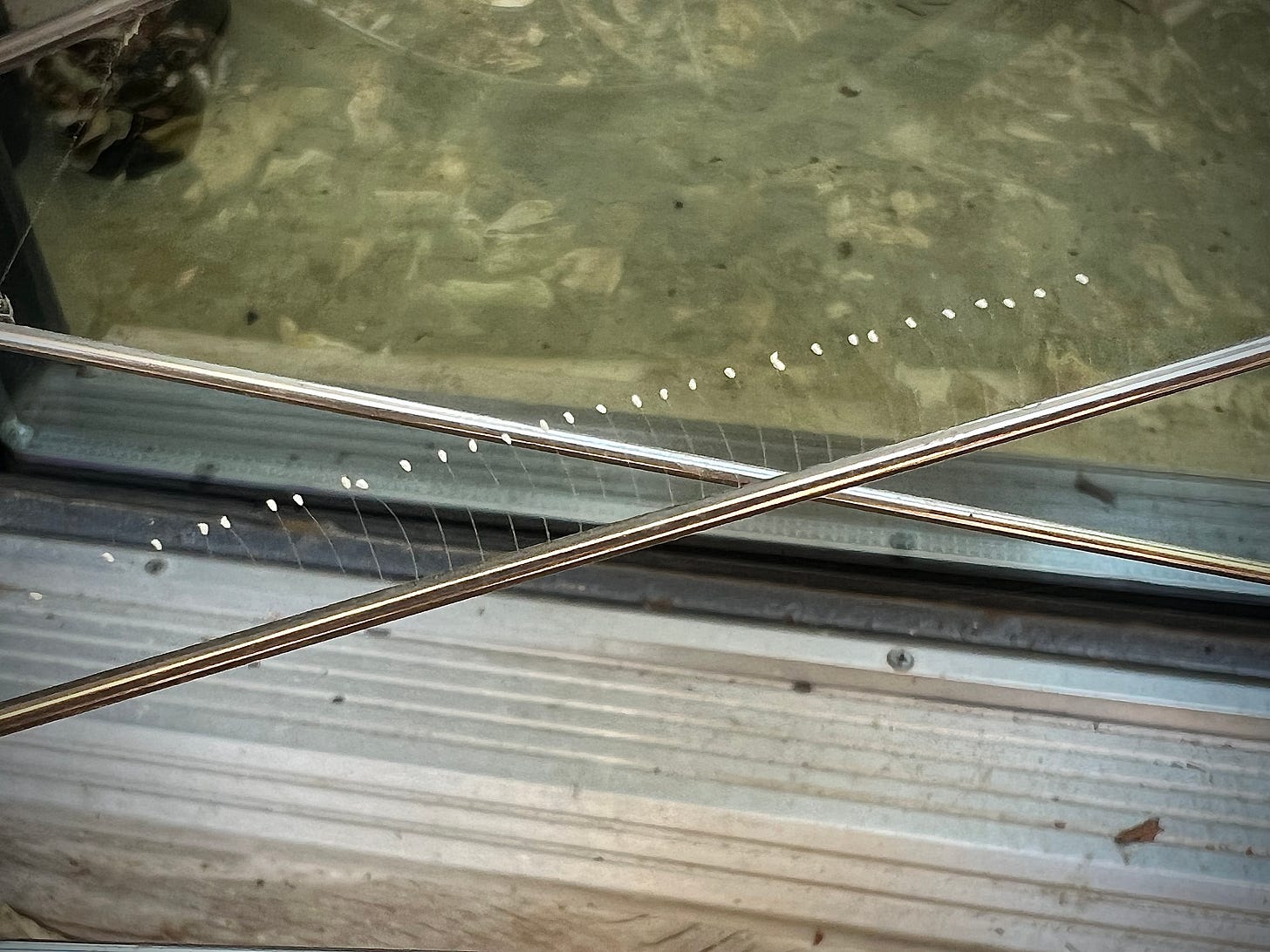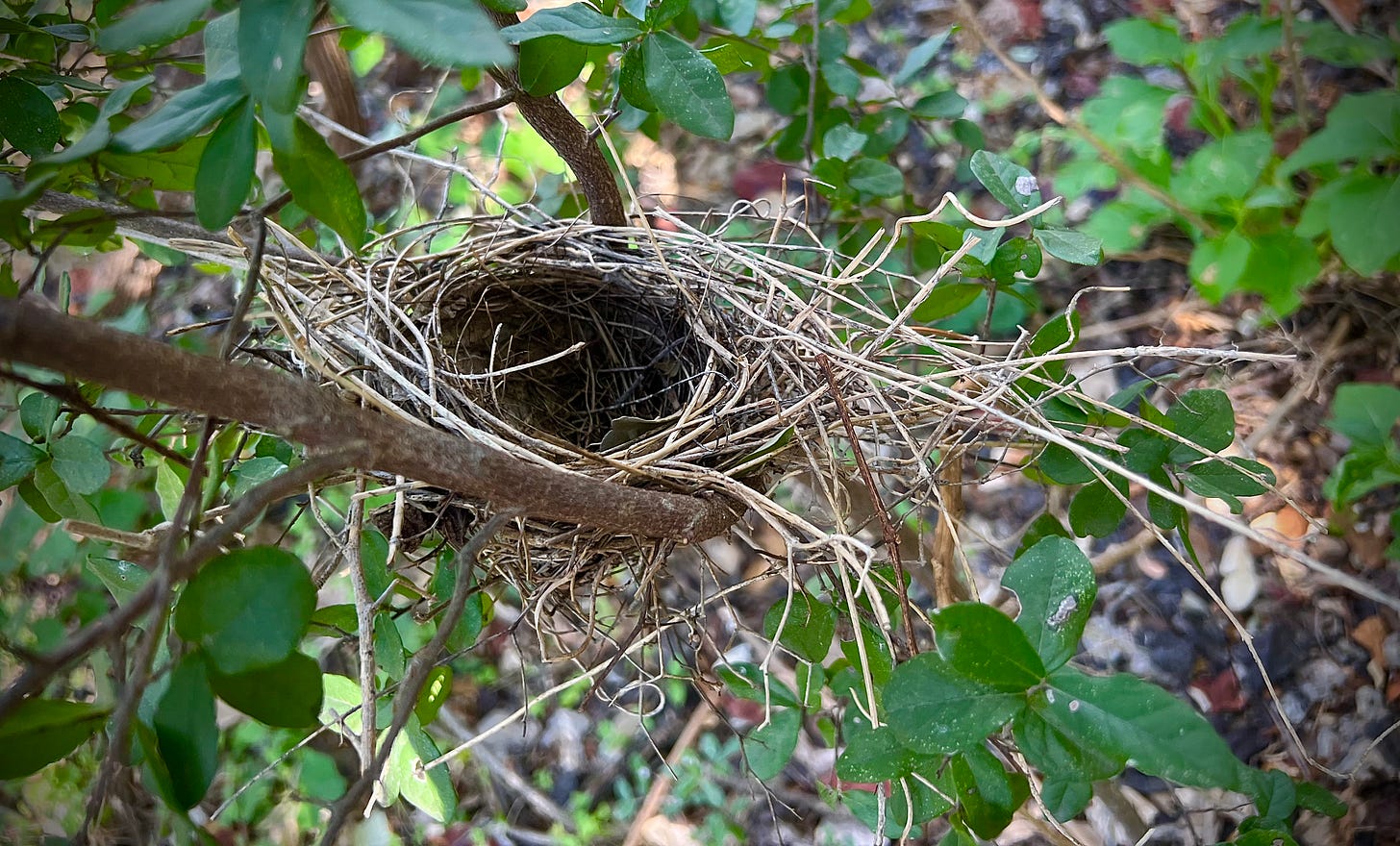The Fox and the Hoover Hog
What passes for autumn in these parts has begun to settle in, even as the leaves are still on most of the trees, and only a few species have even started to bleed off the green. In the mornings the river wraps itself in a romantic fog that hides the trash and the reminders above the treeline that, as green and wild as it is in that pocket, you are in one of the fastest-growing cities in America, and the city wants to eat every pocket of wildness that has somehow been allowed to persist in its margins.
Sunday morning at sunup the black mouth cur and I went out for a walk in that zone, while the rest of the family slept in. She picked the route, taking us back along the public right of way into the field behind the dairy plant, which a local development company has under contract to turn into a high-end mixed use project with up to 95% impervious cover. For the past few decades, that field has been a privately owned buffer around the factory, weedy and flat but adjacent to a wildlife preserve whose animal inhabitants use it as if it were part of the preserve. The field gets mowed every six months or so, which, along with the deer, keeps new trees from growing. That’s why the hawks like to hang out on the telephone poles that follow the right of way along the field’s edge, waiting for talon-sized terrestrial creatures to make their way out into the open. A killing field about which I still find myself feeling a sense of anticipatory loss, even as I am also part of the group working to preserve it as best we can.
Down in the woods behind it, the coyotes have been yipping, summoning the season of folk horror that comes with long nights and fur-friendly weather. Though the only fur we saw that morning was on a man-made hedgehog we found with its paws on a flotsam keyboard in the old Swamp Camp. I wondered if it was an elfin riff on the famous Isaiah Berlin essay, which later got repurposed as business book wisdom about the virtues of specialization for those who want to make more money. There are no real hedgehogs in those woods, only foxes, who do well in the margins of our dominion. Perhaps there’s an alternative parable in there.
When we stepped back out of the woods onto the rocky bank of the river, we heard raptor cry. And when we looked up in the trees there were three of them cavorting—two caracara and a hawk, it appeared, based on the song, though we couldn’t see the hawk, and even the caracara were intensely backlit by the new day’s rising sun. But you could hear the closest of the caracara, and even see it vocalize with that crazy crested head, emitting an ack ack ack that seemed simultaneously erotic and horrific. The satisfied sound of ancient generalists at rest.
A little further on, in bluer sky, the only cloud was one high-altitude contrail, headed in the direction of San Antonio, or maybe some destination beyond the border.
It was the day before Halloween, and when we got back home we had to help get the costume made for our little witch. A project which was mostly the task of mama witch, who had turned it into something of a conceptual art project along the way, obtaining a design through verbal prompts fed to the beta-testing AI tool Midjourney, and then figuring out how to turn the strangely creepy yet cute digital image that resulted into a real thing. A Halloween exercise in how best to negotiate between the natural world we come from and the machine-dreamed world we are making for our children.
As mama sewed, she tasked tiny witch and I with finding some Spanish moss to weave in. And maybe because of the holiday, every step of the way we found little frissons of beautiful horror.
When I went to my old truck to prepare for our excursion, I found this strange creature lurking under the latch of the rear lid. Winged without wings, adorned with little spikes, abdomen curled up like a stinger. A plume moth, I think, one of the Pterophoridae who somehow fly on on bristled spars, and always remind me of the trippy album cover dream machines of the 70s illustrator Roger Dean. Though the soundtrack of a plume moth coming in to feed is probably not Prog.
A little later, when I went to get the bike with the child seat on it ready for our ride, I found 39 eggs on long thin strands grown out from one of the spokes. The second such eggs, or what seemed like they must be some kind of insect egg, that I had seen this season planted on the steel surfaces around our house. The prior clutch was on the frame of our bedroom door, which opens onto the outdoor patio, and was smaller. I had been meaning to try to find out what they were, and after showing them to my fascinated daughter, I learned they must be the eggs of lacewings, a graceful little green flyer whose monster tank larvae can each eat as many as 60 aphids in an hour. I welcome their imminent counter-infestation, and only wish they could have come earlier.
The natural material we were foraging for is something one sees all the time around here, but not in the immediate vicinity of our house. Austinites often call them “air plants”—little balls of dry and evidently rootless vegetation that are often found on the ground, and seem to survive on no more than the air. The sort of plants a child can pick up, hold in their hand and take home. I had never given much thought to the specific ecological circumstances in which one finds them, until tasked to collect some.
It was mid-afternoon when we rode across the bridge to the park, headed for a secret corner where there are some majestic, centuries-old oak trees that memory had me thinking was where we would find what we were looking for. We stopped at the playground along the way, which is a very nice one, even if it has gotten a little beat-up over the summer, with the gates all busted. A trio of boys was taking advantage of this opening to the woods to collect sticks as facsimile weapons, not knowing that the spot they were rummaging around in was where the body of a murder victim was dumped nine years ago, nor that a little further back, in the bamboo at the edge of the bluff, is the outlaw shanty of an aggressive thief who has real weapons. The new fairy tales practically write themselves, even if we are too coddled to acknowledge them.
We rode on up the hill to the secret spot, locked the bike up at the trailhead, keeping an eye out for mesquite thorns, and stepped into the forest. We didn’t even have to go all the way in to find some live oaks, and sure enough, the Spanish moss was there. Mostly still on the tree, but with a little looking we found some that had fallen. We also found this very fine nest in the nook of an even younger tree. Bag loaded, we headed back, and the costume was soon done. In the image below, you can see the AI design on the left, and what Mom made on the right.
While the brujas finished that work, I went for a run, and came upon a fresh bit of graffiti—a column under the tollway that had been festooned in pink cursive spray paint with the nickname I gave my paternal grandmother: Bunga. I took a picture, and found myself, in my desire to share this wry serendipity with my brother and my dad, feeling for the first time the absence of both of them, even as the moment made me realize how their network ghosts are still there, in the box of light I carried in my hand. The digital traces the dead now leave behind, and that sometimes the algorithms inadvertently resuscitate.
Thursday morning, half way through a long week that would end with an extra hour designed to bring back the night, I went for a run in the woods behind the factories and got further confirmation of the change in seasons when I heard some rustling just off the trail. An armadillo, foraging. In summer one only sees them at night, but when the temperatures cool they sometimes come out in the light. This one took a long time to notice me. When it did, it started to bolt, then stopped, got up on its back legs, and put its nose to work for a long moment taking in my scents. As if we’ve encountered each other before. Then it scrambled off into its nearby burrow, made from a crevice in the dirt beneath a chunk of old concrete.
During the Great Depression, armadillos were a popular alternative to pork, so popular they earned the nickname “Hoover Hogs.” The armor would often be used to make household items like lampshades. The knowledge since acquired that twenty percent of armadillos in our domain carry leprosy will probably ensure those practices don’t come back, even if we find ourselves in similar economic circumstances, having to learn how to feed ourselves with a lot less money. Later that day I got to thinking how armadillos are maybe the closest thing we have to a hedgehog. Whether it is a specialist or a generalist is open to debate.
Not long after my encounter with the upright armadillo, I learned that day was a new holiday: Godzilla Day. The chances are slim that a kaiju ‘dillo will arise from the brownfield, transformed by chemical runoff and illegally dumped Tesla batteries, to destroy the simulation of life the software is creating for us, plowing its chubby carapace through the shiny high-rises that look like capital has finally acquired the means of self-expression. But it makes for an epic daydream.
Extra hour reading roundup
When I woke up on the morning after Halloween, my phone prompted me with an alert to look at a photo on Twitter of the company’s new proprietor dressed up to go trick or treating with his mom. I complied, half curious, and was astonished to see them both dressed as supervillains, him in crazy red beast armor and her in S.S.-grade black leather trench coat and shit kickers. It was remarkable in the insights into the psychology of both of them that it revealed, even in the photographic portraits of her you could see framed on the wall behind them, in what must have been her New York apartment. And in what it revealed about how this society works.
It was nine years ago while screwing around on Twitter with some like-minded post-cyberpunk friends and colleagues that I shared the above photo from the website of Palantir Technologies, a Peter Thiel-backed company I had learned of that morning in a New York Times story that outed them as the authors of the algorithms the NSA used to sort our emails for thoughtcrimes. The company’s name, after the seeing stones used by the evil wizards of Tolkien’s Lord of the Rings to spy on and control others, was weirdly brazen in its acknowledgement of the moral orientation of their business model. When you went to the website, it was like an insane Terry Gilliam satire in its self-parodic mash-up of government surveillance and flip flops at work. And there, in the middle of these clowns putting the bro in Big Brother, was another stuffed hedgehog. Animal avatar of hyper-specialization in service of the generation of surplus, and the absence of moral accountability that comes with focusing only on your assigned tasks and not even having time or ability to see the big picture.
I spent a lot of time on Twitter in its first decade, most of it quite rewarding, developing many collegial relationships that continued in real life. In time, the algorithms got better tuned to make money by screaming for your constant attention, which turned the platform into a spectacular amplifier of American extremism, after which I mostly used it to promote my books, share photos of weird things I saw in the urban woods, and, more recently, get the word out about Field Notes. This week I have been reading a lot of smart commentary about Twitter and contemporary media culture by folks who are mourning its obvious demise, including this Caleb Crain essay this weekend in his wonderful newsletter, Leaflet, about the idea of “Information Hygiene.” Maybe it’s because his feed is also so full of beautiful photos of birds that it got me thinking about how Twitter is named after the sound of morning birdsong, and about the opportunity the decline of these great social platforms gives us to put our phones away, step outside, and listen. Not that we can’t do both.
Substack, the platform that hosts this newsletter, is eager to welcome (or capture) Twitter refugees. So much so that it has enabled a new chat feature for those who read Substacks on the company’s dedicated phone app. I have turned that on for Field Notes, as an experiment that may be quickly aborted. The faux friendliness of the marketing communications soliciting your participation can’t mask what a transparent effort it is by an ascendant platform to maximize engagement and monetize your mind. Maybe there’s a way to renegotiate those terms. But I think the better response to the demise of Twitter is to start sending each other snail mail, so I am going to see if there’s a way to do a periodic print edition of this newsletter. Like a more feral version of The Kiplinger Letter my dad used to get. In the meantime, the chat is open.
While working on The Secret History of Empty Lots this week, my research got me re-reading Kenneth Jackson’s excellent Crabgrass Frontier, a history of the suburbanization of the United States. I first read the book when the paperback edition came out while I was in college, and it holds up well, including in the opening glimpse of what life was like in the walking cities of early America. The natural history is lurking in the negative space of the book, but it’s there.
On the subject of urban coyotes, this NYT piece from a few weeks ago about the diet of NYC’s wild urban canids is pretty cool. “Coyotes may be living in the city, but they are living alongside us, not off our stuff.” And for a deeper dive, you can go straight to the Gotham Coyote Project.
Thanks to ex-New Yorker Nathaniel Chapin for sharing this beautiful poem by David Baker, “Six Notes,” with its evocations of urban wildlife encounters in a dying world, that appeared this week in the Halloween issue of The New Yorker.
Lastly, here’s the full (but somewhat shaky) video of my Godzilla Day armadillo encounter, which shows in an action-packed minute many of that animal’s astonishing and sometimes hilarious qualities:
Have a great week, and enjoy the extra hour.












This was an excellent read for me especially since I recently got introduced to the process of Documented Walks which you have captured quite succinctly while reflecting on your own journey.
I’m all in for snail mail.